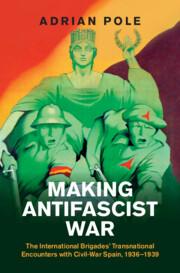
- Publisher:
- Cambridge University Press
- Online publication date:
- October 2025
- Print publication year:
- 2025
- Online ISBN:
- 9781009601665

This is a study of the 35,000 antifascists who joined the International Brigades in order to defend the Second Spanish Republic and of their encounters with civil-war Spain. Dr Adrian Pole offers the first in-depth history of the rich array of cross-cultural encounters which emerged between the multinational soldiers of all five International Brigades and the people, places, politics and culture of the country which accommodated them for almost three years of civil war. He sets out to recover the place of these encounters within the making, imagining and running of a transnational fighting force, showing how they influenced the volunteers' experiences and emotions, underlined their ideas and identities, informed their motivations and actions, and ultimately underpinned their ability to imagine, wage and justify the war. In doing so, he demonstrates how they enabled thousands of transnational actors to define a deeply contentious conflict in their own very particular terms.
‘Making Antifascist War movingly reconstructs the International Brigades' interactions with the men, women, and children of civil war Spain. Exploring these complex transnational encounters, Adrian Pole offers new insights into the volunteers' sense of themselves as fighters in a global antifascist struggle.'
Lisa Kirschenbaum - West Chester University
‘Interest in the role of the International Brigades in the Spanish Civil War seems never to abate. As long as wide-ranging, original and challenging works like Adrian Pole's Making Antifascist War continue to appear that is likely to remain the case for a long time to come.'
Sir Paul Preston - London School of Economics
 Loading metrics...
Loading metrics...
* Views captured on Cambridge Core between #date#. This data will be updated every 24 hours.
Usage data cannot currently be displayed.
This section outlines the accessibility features of this content - including support for screen readers, full keyboard navigation and high-contrast display options. This may not be relevant for you.
The PDF of this book complies with version 2.1 of the Web Content Accessibility Guidelines (WCAG), covering newer accessibility requirements and improved user experiences and achieves the intermediate (AA) level of WCAG compliance, covering a wider range of accessibility requirements.
Allows you to navigate directly to chapters, sections, or non‐text items through a linked table of contents, reducing the need for extensive scrolling.
Provides an interactive index, letting you go straight to where a term or subject appears in the text without manual searching.
You will encounter all content (including footnotes, captions, etc.) in a clear, sequential flow, making it easier to follow with assistive tools like screen readers.
You get concise descriptions (for images, charts, or media clips), ensuring you do not miss crucial information when visual or audio elements are not accessible.
You will still understand key ideas or prompts without relying solely on colour, which is especially helpful if you have colour vision deficiencies.
You gain clarity from ARIA (Accessible Rich Internet Applications) roles and attributes, as they help assistive technologies interpret how each part of the content functions.